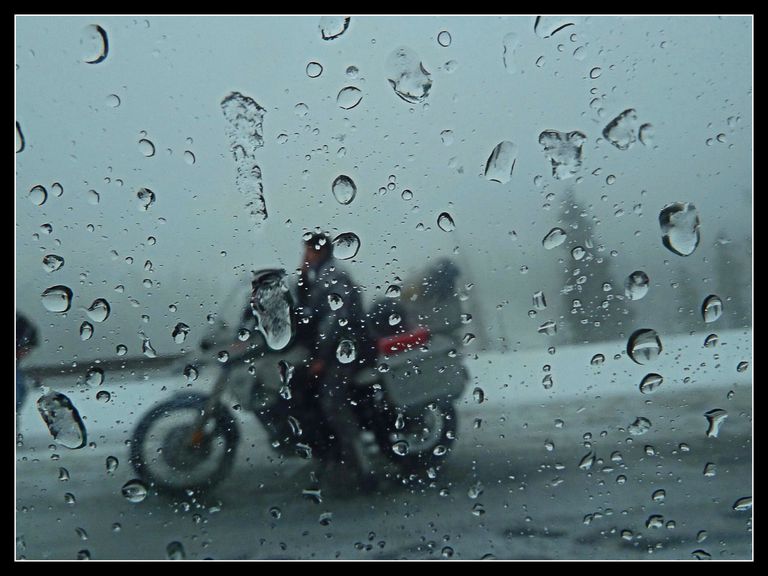How to ride in the wet

You know the feeling. You’ve been looking forward to a ride all week. The bike is ready on the driveway; tyre pressures checked, chain adjusted. Suit up, grab keys, head out and before the end of the road there are spots of rain hitting your visor. Those little droplets of anti-grip can make you want to spin around and head straight back to the comfort of the garage, but stick with it and follow our top tips for riding better in the rain. Whether you’re on the road or on the track, getting comfortable riding well in the wet means more time enjoying your bike and even more confidence when it dries up.
Step One – Read the rain
Drops, drizzle, showers, mizzle, mist, downpour and hail – all rain is not created equal and riding in the wet requires you to consider much more than just the amount of water in your boots. On a warm, dry day, a few spots of rain appearing on your visor is what bike racers lovingly refer to as ‘Mental Rain’, i.e. it’s not really there, just in your mind. On a racetrack that works – you’re not travelling any great distance in one direction, so you can work on the fact that a few spots of rain aren’t going to seriously affect grip. On the road, it’s a little more complicated – but if the road surface is dry and the spots of rain have just started, grip levels aren’t going to have taken a hit. More significant is temperature, specifically that of your tyres. The biggest problem racers have when it starts raining mid-race is that the wet track means they have to do everything less aggressively (braking, accelerating, cornering). Combined with the cooling effect of the water on the track this means tyre temperatures begin to drop, which is when grip starts to take a significant hit. Road tyres are designed to continue working at lower temperatures, but the theory still applies – on a cold morning, when you’ve just left the garage or after a café stop, the tyres will produce less grip and less feel. That’s one of the big reasons why the first miles of a cold, wet ride can leave you doubting whether it’s worth going out at all. The solution is to understand that tyres, suspension and your body all need time to warm up, so take it steady and build up gradually. Two extra factors to consider are the amount of rain on the road and when it last rained. The first rain after a long, dry spell seems to bring all the grease and dust to the surface and can make roads particularly greasy. If it’s properly hammering it down, the grip can still be good, especially on a well-treaded tyre, just keep an eye out for standing water and bigger puddles.

Step Two – Read the road
Track or road, one of the biggest differences between riding in the rain and riding in the dry is that the change in grip levels across different surfaces will be far more pronounced. On a track this mainly applies to the kerbs and white lines, but on the road you have to factor in drain covers, spillages and different road surfaces too. One thing that is common to track and road is how important it is to keep reading the surface conditions and re-assessing at every corner. A wet track will change lap by lap, sometimes for the better, sometimes not and the same applies on the road. Racers use the back brake in a straight line as a way to feel how much grip there is on a sighting lap before the race, but on the road you have to rely on feel from the tyres and experience. Modern bikes help with this – ABS and traction control both give us a safety net if we do overstep the mark, but the best approach is still to build up gradually.
Step Three – Gently does it
There are lots of good analogies about how to adjust your riding for wet weather, but they all boil down to the same principal – carry on riding as you normally would, but do everything more smoothly. Apply the brakes more gradually, be smoother on that gearshift, tip in to corners with a gentle touch. Everything you do needs to be done with a longer build up than in the dry to give the bike time to transfer weight to the tyres and get you grip. Just as important as coming onto the brakes or throttle gradually is releasing them smoothly. This is especially important to remember when you’re braking up to a corner. Letting go of the brake lever all in one go and then turning in means the bike’s forks will be going light from coming off the brake, right when you need weight and grip on them to turn in. Plan ahead with your braking and give yourself time to transition smoothly from braking to turning.
Riding in the rain can be fun, but you’ve got to give yourself time to acclimatize and build confidence. Read the road or track conditions carefully, consider the temperature and let the tyres build heat before you ask too much of them. On track is the best place to get your water wings, as the conditions are as consistent as you’re likely to get. Ride smooth, plan ahead and relax and you’ll be amazed at how much pace you can carry on track in the wet. On the road, a larger safety margin has to take priority, but you can still enjoy a good twisty road if the surface is good and you stay smooth on the bike.

#StaySafe, #StayAlert, #StayPositive and keep washing those hands (yes, it’s still important!).


